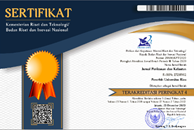Economic Valuation of Mangrove Ecosystem in Rempang Island, Batam City, Kepulauan Riau Province
(1) Department of Environmental Science, Postgraduate, Universitas Maritim Raja Ali Haji
(2) Department of Environmental Science, Postgraduate, Universitas Maritim Raja Ali Haji
(3) Department of Environmental Science, Postgraduate, Universitas Maritim Raja Ali Haji
(4) Department of Environmental Science, Postgraduate, Universitas Maritim Raja Ali Haji
(5) Department of Environmental Science, Postgraduate, Universitas Maritim Raja Ali Haji
(*) Corresponding Author
Abstract
Keywords
Full Text:
PDFReferences
[DLH] Dinas Lingkungan Hidup Kota Batam. (2023). Kerusakan lingkungan di Kota Batam. Batam.
Ariftia, R.I., Qurniati, R., Herwanti, S. (2014). Nilai ekonomi total hutan mangrove Desa Margasari Kecamatan Labuhan Maringgai Kabupaten Lampung Timur. Jurnal Sylva Lestari, 2(3): 19–28.
Fahrudin, A. (1996). Analisis ekonomi pengelolaan lahan pesisir Kabupaten Subang, Jawa Barat. IPB University. Bogor.
Febriannaningsih, B.A., Khakhim, N. (2015). Aplikasi citra Landsat TM (Thematic Mapper) dan Oli (Operational Land Imager) untuk pemetaan perubahan tutupan dan kerapatan mangrove tahun 1990-2015 di Pulau Batam dan sekitarnya. Jurnal Bumi Indonesia, 4(4): 1–10.
Freeman, A.M. (2003). Economic valuation: What and why BT - A primer on non-market valuation (P. A. Champ, K. J. Boyle, & T. C. Brown, Eds.). Dordrecht: Springer Netherlands
Haga, J., Siburian, R. (2016). Konservasi mangrove dan kesejahteraan masyarakat. Yayasan Pustaka Obor Indonesia. Jakarta
Ismail, K., Habibah, S.N. (2023). The low level of sustainability of fishing households livelihood assets around marine conservation areas. Bio Web Conferences,06003.
Karminarsih, E. (2007). The use of ecosystem mangrove in minimalize disaster impact in beach area. Jurnal Manajemen Hutan Tropika, 13(3): 182–187.
Kelurahan Rempang Cate. (2023). Profil Kelurahan Rempang Cate.
Kelurahan Sembulang. (2023). Profil Kelurahan Sembulang.
Keputusan Gubernur Kepri. (2023). Standar satuan harga Provinsi Kepri tahun anggaran 2024. Pub. L. No. 1103 tahun 2023, 1151. Republik Indonesia: Pemerintah Provinsi Kepulauan Riau.
Khairunnisa, K., Abdillah, Y., Wahyudin, W. (2022). Value of the mangrove ecosystem in Kawal Village, Bintan Regency. Journal of Akuatik Lestari, 5(2): 97–101.
Khodijah, K. (2014). Sustainable livelihoods of fishermen households headed by women (Case study in Riau Islands Province of Indonesia). Asian Social Science, 10(9).
Kurniawati, N.D., Pangaribowo, E.H. (2017). Valuasi ekonomi ekosistem mangrove di Desa Karangsong, Indramayu. Jurnal Bumi Indonesia, 6(2).
Purnamasari, F., Adi, W., Febrianto, A. (2022). Identification of the economic value of the mangrove forest ecosystem in the District of Tanjung Tedung Central Bangka Regency. Journal of Tropical Marine Science, 5(2): 111–120.
Ruitenbeek, H.J. (1992). Mangrove management: An Economic analysis of management options with a focus on Bintuni Bay, Irian Jaya. Canada.
Ruitenbeek, H.J. (1994). Modelling economy-ecology linkages in mangroves: Economic evidence for promoting conservation in Bintuni Bay, Indonesia. Ecological Economics, 10(3): 233–247.
Sambu, A H., Sribianti, I., Chadijah, A. (2018). Model pengelolaan mangrove berbasis ekologi dan ekonomi. Inti Mediatama. Makassar.
Setiyowati, D., Supriharyono, S., Triarso, I. (2016). Economic valuation of mangrove resources in the Mangunharjo Village Tugu Sub District, Semarang City. Saintek Perikanan, 12(1): 67–74
Article Metrics
Abstract view : 43 timesPDF - 23 times
DOI: http://dx.doi.org/10.31258/jpk.29.2.266-274
Copyright (c) 2024 Ladies Nikita Alamanda, Khodijah Ismail. Wahyudin, Ani Suryanti, Sayyidah Nur Habibah

This work is licensed under a Creative Commons Attribution-NonCommercial-NoDerivatives 4.0 International License.
Gedung Marine Center Lt 2. Fakultas Perikanan dan Kelautan Universitas Riau



